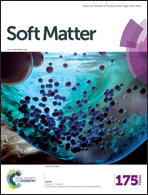Structure and flow of dense suspensions of protein fractal aggregates in comparison with microgels†
Abstract
Solutions of the globular whey protein β-lactoglobulin (β-lg) were heated at different protein concentrations leading to the formation of polydisperse fractal aggregates with different average sizes. The structure of the solutions was analyzed with light scattering as a function of the protein concentration. The osmotic compressibility and the dynamic correlation length decreased with increasing concentration and became independent of the aggregate size in dense suspensions. The results obtained for different aggregate sizes could be superimposed after normalizing the concentration with the overlap concentration. Dense suspensions of fractal protein aggregates are strongly interpenetrated and can be visualized as an ensemble of fractal ‘blobs’. The viscosity of the heated β-lg solutions increased extremely sharply above 80 g L−1 and diverged at 98 g L−1, mainly due to the sharply increasing aggregate size. At a fixed aggregate size, the viscosity increased initially exponentially with increasing concentration and then diverged. The increase was stronger when the aggregates were larger, but the dependence of the viscosity on the aggregate size was weaker than that of the osmotic compressibility and the dynamic correlation length. The concentration dependence of the viscosity of solutions of fractal β-lg aggregates is much stronger than that of homogeneous β-lg microgels. The behavior of fractal aggregates formed by whey protein isolates was similar.


 Please wait while we load your content...
Please wait while we load your content...